Taking Measure
Just a Standard Blog
Getting Food on Our Tables From the U.S. and Around the World, Safely and Less Wastefully

Standardized data will connect farmers, inspectors, manufacturers, shippers, and ultimately consumers to ensure the freshest, most high quality food possible.
I’m still amazed to see strawberries, avocados and watermelons in my grocery store out of their “normal” season. As amazing as this is, I know it means that my food is arriving from far-flung destinations and may be subjected to poor conditions or handling along the way. So, now, even more so than before, I regularly check where the fresh fruit or produce is hauled in from. Instinctively, I try to remember any recent news of recalls due to foodborne illness. Did I hear about any recalls or hospitalizations lately?
Yes, grocery shopping does give me pause these days.
A recent study found that “addressing drivers of food waste can slash the value of food lost and wasted every year globally by nearly $700 billion.” Clearly, moving food from farm to table nowadays is not without challenges, to say the least. Yet, there are some outstanding developments that are starting to help address these safety and waste issues.
For example, food manufacturers and distributors are beginning to attach new internet of things (IoT) sensors to food shipping containers. These IoT devices use the regular internet communication infrastructure (the same as your email app does) to “talk” to senders and receivers of the containers about their temperature, humidity and other conditions, including unauthorized tampering with the contents. These sensors provide critical and useful information to the monitoring systems of both the sender and the receiver of the shipments.
Also, to achieve efficient delivery, up-to-date information on things like shipment plans needs to be exchanged among all partners.
And, at the end of the supply chain, before appearing in grocery stores, the crops and food shipments may need to pass quality tests. Hence, laboratories and their partners must electronically exchange testing information such as inspection orders, test specifications and test results.
As you can see, more than ever, moving food safely and efficiently around the U.S. and the world requires that partners in the food supply chain exchange important information in a usable and timely manner. Before that can happen, however, a community of stakeholders, including food manufacturers, IoT device-makers and operators in the food supply chain, needs to find a meaningful and feasible way of representing that data to assure it is communicated and interpreted as intended.
Standards development organizations (SDOs) are uniquely equipped to bring together stakeholders from many industries and countries to design feasible ways to exchange data among their devices and systems. One of the SDOs — Open Applications Group Inc. (OAGi) — has a long history of developing its OAGIS (Open Applications Group Integration Specification) standard for many industries and took on the task of enabling the necessary food-supply-chain standards by extending OAGIS.
With this focus, the OAGi members collaborated to deliver the OAGIS standard extensions needed by the food supply chain partners. Multiple problems surfaced quickly, and the OAGi organization and their dedicated, small group of industry volunteers found themselves facing a large, and possibly unfeasible, task. It was then that they invited NIST experts to work with OAGi and its members to help address the issues.
First, information exchange requirements from various food-supply-chain sources needed to be extracted and reconciled. This meant that NIST experts had to develop detailed models and document integration scenarios to give the particulars of the process flow and messages exchanged among the collaborating partners. One was the ‘Item Nonconformance’ scenario for reporting the failure of a product to meet some specified values or criteria. The team had extensive interactions with food manufacturing companies to interpret their often-informal statements about a product’s failure into software-implementable data specifications. For example, when describing a nonconformance situation, it was important to clarify what the problem was and how to codify lot, job and serial numbers in a certain production run.
Second, the existing OAGIS standard is already serving many industries, which use different terminologies depending on the specific industry. The mismatches with existing terminology were typically due to the perishable nature of the food products and the stringent FDA regulations that must be followed to ensure food safety and traceability. This meant that NIST experts had to reconcile the differences between the various OAGIS usage specifications in currently supported industry sectors.
The third and final challenge was that the existing OAGIS standard was in a different form than the one used by small IoT sensor and mobile devices, such as smartphones and tablets, to communicate. This meant that NIST experts not only had to develop an efficient way to represent the standard in a completely new form, but also had to assure that this new form was in sync with the one already in existence. The team had to implement a new OAGIS expression to allow the new data formats used by mobile and IoT devices.
These issues took the dedicated OAGi volunteers and NIST experts more than a year to resolve. OAGi released a new version of its standard, OAGIS 10.4, in 2018, which is a direct result of input from NIST and industry partners, including Archer Daniels Midland, Land O’Lakes, Oracle and Boeing. The OAGIS standard has since been successfully adopted into the food manufacturing industry.
Scott Nieman, expert enterprise integration architect at Land O’Lakes, acknowledged the improvements made after adopting the new standard along with the NIST-developed open-source software, saying, “We are seeing threefold improvement in productivity when using the NIST-enabled standards and software. These improvements in productivity are seen in data exchanges about orders and shipments and exchange of quality-related information for inspection and test results at Land O’Lakes factories and with its suppliers.”
Jim Wilson, CEO of OAGi, noted the beginnings of a paradigm shift thanks to the collaboration. “NIST has helped agriculture-industry domain experts view agricultural production more like a manufacturing process, which introduces a myriad of optimization opportunities,” he said. “Thanks to NIST research, in partnership with industry leaders, system interoperability is improving, thereby improving the competitive position of United States companies.”
As a result of our work, one could say that farms all over the world can now continue to supply U.S. customers with a greater sense of safety. Not only that, but small U.S. producers around the country, too, will now be able to increase their distributions with greater assurance of safe, healthy and on-time delivery of the food.
With a foundation of logistics and testing standards completed and turned over to the industry, the next step is to develop an efficient data exchange standard for the IoT sensors. With these standards, the manufacturers and distributors will be able to cost-efficiently use IoT devices, which will be able to talk in real-time to the food supply chain partners about the state of the food being shipped. This is the next challenge, and NIST has already begun working on it. Stay tuned!
About the author
Related Posts
Comments
IoT next big thing






Good information. Buying food is a problem in winter. I usually shop the local food stores and or the small one.